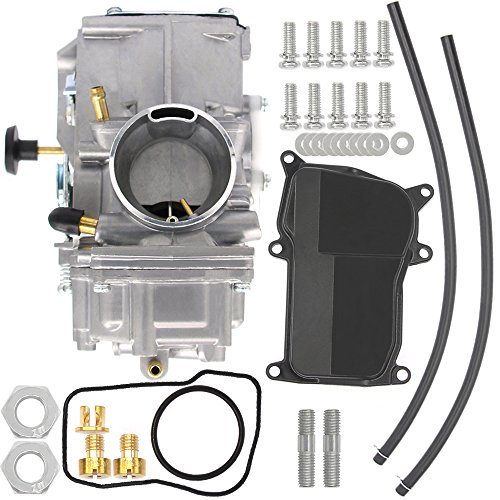It happens all the time, water gets sucked into your engine or somehow makes its way into your gas tank. It makes sense with all the puddles, rivers, and streams you ride through out on the trail. Or maybe the gas tank was left open and it rained quite a bit.
However it happened, you need to remove the water from your fuel tank or engine before you try to start up the machine. It’s not a very hard process and if you follow the steps below, you will be able to start your engine without causing any damage.
They do make a Fuel System Water Remover found here on Amazon. But this is only really useful for small amounts of water and this will only remove water from your fuel system. To completely clean all water out of your machine, follow the steps below.
The most common results from running an ATV with water in the engine include, blown piston rings, blown valves, or a hole in the cylinder wall or head. You see the engine was made to compress an air/fuel mixture.
The air/fuel mixture will compress by the piston moving up, to the point where a spark will light it causing a small explosion which sends the piston back down. Water doesn’t compress. So if there is water in the combustion chamber when the piston is moving upwards trying to compress an air/fuel mixture. The pressure gets to be too much and the water will find its way out of the cylinder somehow.
Usually it will just blow a piston ring, but those aren’t fun to replace. In any matter, it’s best to remove the water from the engine and the fuel before trying to start the ATV. So lets get into the steps to do that.
If ever think you’re getting water in your ATV engine, like if you’re in really deep water or something. It’s best to shut the engine off immediately. As you can see in my picture in the sidebar, I’ve done this before. Thankfully I shut the engine off as I started to feel the ATV bog down and prevented any real damage from happening.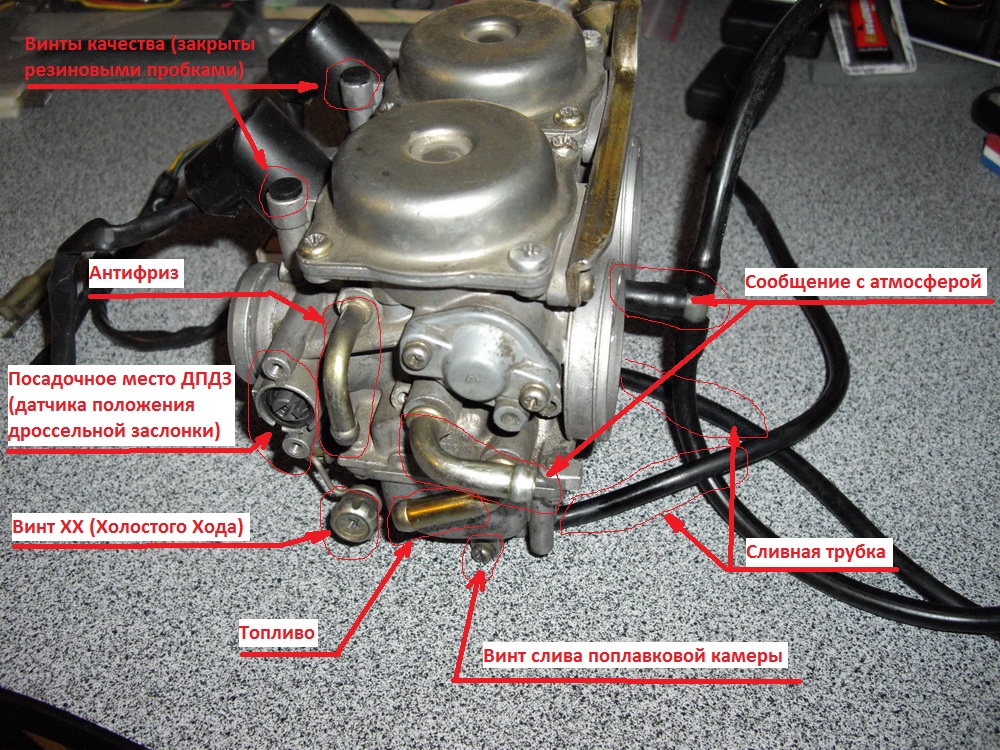
Luckily you shut the engine off before any real damage was done too, right. If so, follow these steps before trying to start your ATV again.
Check the air filter first, none of the other steps will do you any good if your air filter is wet when you go to try starting the machine up again. If the air filter is wet, take it out of the air box.
Wipe the air box out with paper towels or rags and let dry completely. If you can get your air filter to dry out, you might be able to use it again. Just make extra sure it’s completely dry inside and out.
Drain the fuel tank, fuel lines, and clean the carburetor if your engine has one. While you’re at it, drain the oil and remove the oil filter too. If any water got in your oil, it could cause some major problems for you later on.
I like to spray some carb cleaner in all the ins and outs of the carburetor just to make sure any water in there gets removed. It’s a good idea to let your gas tank air dry after you drained it as well.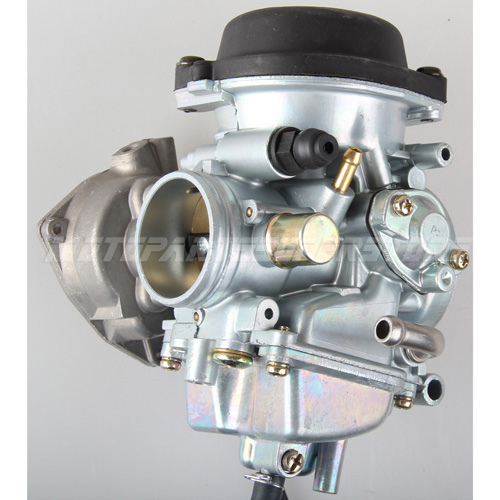
You’ve already drained the oil out of the engine and removed the oil filter, so now to force the water out of the cylinder, remove the spark plugs and turn the engine over a few times. Most of the water should have come out when you drained the oil, but this will help get any remaining water out.
Refill the engine with oil, put on a new oil filter, and turn the engine over again, with the spark plugs still taken out. You’re going to want to look at the oil after you’ve let it sit for a few minutes. You’re trying to see if there is any water mixed in with the new oil you just added. If there is water you will see white colored milky areas rising to the top of the oil.
If you see water in there still, drain the oil and do those steps again. You really want to make sure there is very little or no milky white stuff in the oil.
Put the spark plugs back in, put some fresh fuel in the tank, and see if it’ll start up.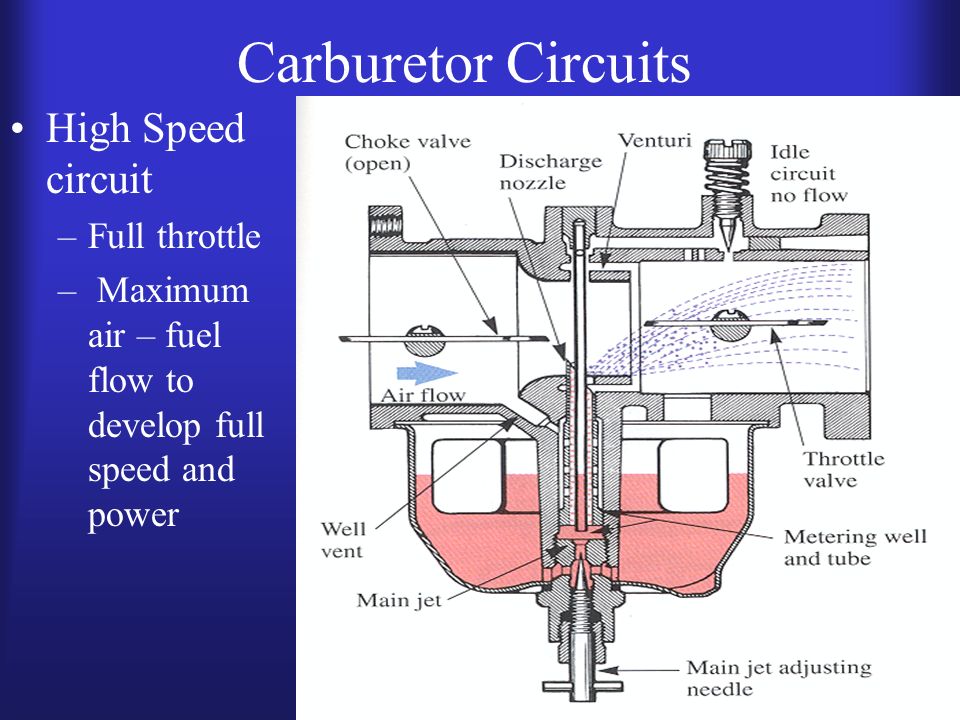 After you let it run for a few minutes, check the oil again for water. If you don’t see any milky white liquid in the oil, you should be good to go. If you do see some, change the oil and filter again until you don’t see any water in the oil.
After you let it run for a few minutes, check the oil again for water. If you don’t see any milky white liquid in the oil, you should be good to go. If you do see some, change the oil and filter again until you don’t see any water in the oil.
If it does not start up, you may have done some damage. You will probably want to check the piston rings, piston, and cylinder for damage. I sank an old Polaris Scrambler when I was younger, and water got into the engine. The piston rings were shot and needed to be replaced.
If you want some tips on how to get an ATV to run again by doing a tune-up check out my, ATV Won’t Start: Common Problems And How To Fix article.
With some of the terrain you ride through, it may be impossible to avoid water. But do try to avoid going too deep. Try to keep your exhaust and air filter above water at all times. Your air filter may be in an air intake box, if so, keep that above water also.
You could also try adding a snorkel kit to your ATV. Snorkel kits allow you to go into deeper water with your ATV without the worry of doing damage to your engine. To learn more about snorkel kits and how to make one yourself, check out my How To Snorkel An ATV article.
Sharing is caring!
The Yamaha Raptor ATV boasts of the largest cc displacement of any sport ATV available. With a triple disc brake system under its ergonomic design, this ATV is not just built for speed but for precise handling as well. The ATV is easy to ride and is equipped with an electric push-button for easy start-up. To maintain their Raptor’s condition, ATV enthusiasts make sure that their bikes are clean, inside and out.
A clean, well-tuned carburetor is a key factor in the performance of your Yamaha Raptor ATV and nothing makes cleaning carburetors faster, safer and easier than an ultrasonic cleaner.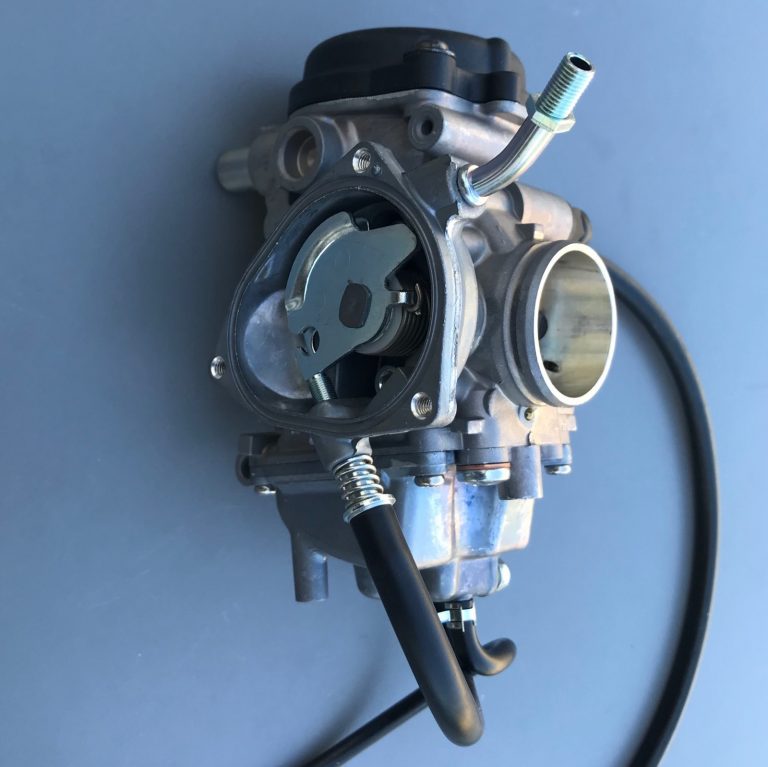 Whether you operate a Yamaha Raptor ATV service shop or do it yourself, you’ll be amazed at just how thorough an ultrasonic cleaner can be in removing varnish, grease, oil and other contaminants from one of the most intricate assemblies on your Yamaha Raptor ATV.
Whether you operate a Yamaha Raptor ATV service shop or do it yourself, you’ll be amazed at just how thorough an ultrasonic cleaner can be in removing varnish, grease, oil and other contaminants from one of the most intricate assemblies on your Yamaha Raptor ATV.
Here you will learn:
How an Ultrasonic Carburetor Cleaner Works
How to Select and Set Up your Ultrasonic Cleaner
How to Remove, Clean and Reinstall your Yamaha Raptor ATV carburetor
How Ultrasonic Parts Cleaners Work on your Yamaha Raptor ATV Carburetor
Ultrasonic cleaners are used in a wide range of applications to remove virtually any soil or contamination by using the power of cavitation action. This is the term used to describe the implosion of billions of minute bubbles contacting carb parts being cleaned. The bubbles are created by generator-powered ultrasonic transducers bonded to an ultrasonic cleaning tank and typically operate at an ultrasonic frequency of 37 to 42 kHz (37,000 to 42,000 cycles per second).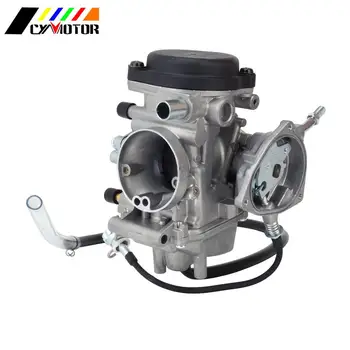
When the bubbles implode contaminants are quickly and safely blasted away from wetted surfaces without damaging delicate carb parts. So tiny are the bubbles that they penetrate minute cracks, crevices and blind holes impossible to reach by hand scrubbing using conventional parts washers or aerosol sprays The ultrasonic parts washer will complete the job in less than an hour, meanwhile freeing you up to attend to other tasks. And it will do it in an environmentally friendly manner because the ultrasonic carburetor cleaning formula is a biodegradable concentrate that minimizes disposal problems.
How to Select and Set Up your Yamaha Raptor ATV Ultrasonic Carb Cleaner
Ultrasonic carb cleaners come in a variety of sizes from bench top units to a floor-mounted industrial ultrasonic cleaning machine, so you can select any size you need. Our most popular 1½ gallon models for cleaning one carburetor at a time are the TOV150-6L and Eh250EL. Select an ultrasonic carb cleaner equipped with a heater to improve the ultrasonic carburetor cleaning process.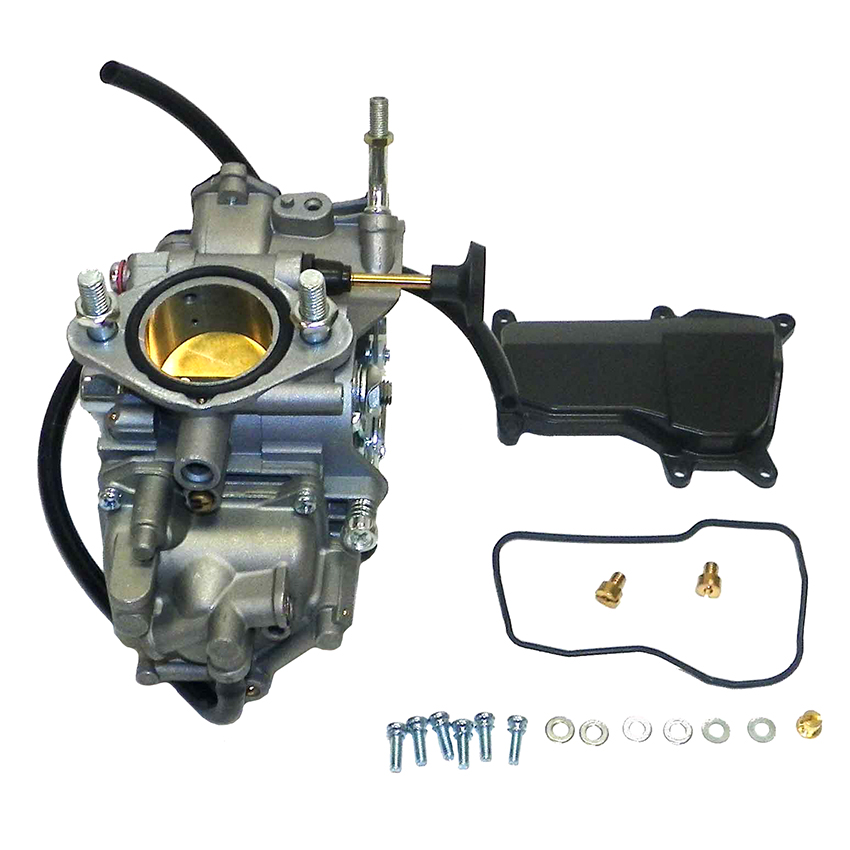
Whatever the model and size ultrasonic carb cleaner you use there are steps to take before cleaning begins.
How to Remove, Clean and Reinstall your Yamaha Raptor ATV Carburetor
Step 1: Removing the Carburetor
Firstly, take off both the air filter housing and the air filter as well. Using a screwdriver, loosen the two screws to get access to the fuel tank. To do this, you will need to remove the two allen bolts securing the front panel with an allen wrench. Take the lights off to be able to remove the fender.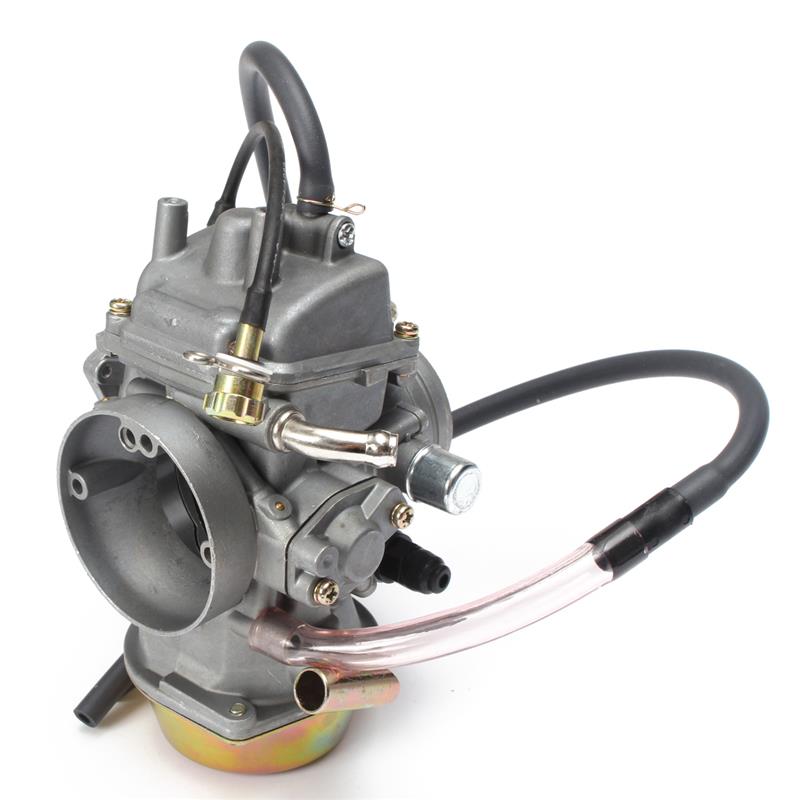 You will have to unscrew the two screws to remove the front fender.
You will have to unscrew the two screws to remove the front fender.
Remove the fuel tank cover. Using a screwdriver, loosen the screws in front of the radiator and the screw holding the tank together. The next thing that you will need to do is to disconnect the fuel line with the help of needle nose pliers. Take out the three bolts, specifically the two front bolts and one rear bolt to be able to lift the fuel tank. Save the washer.
Remove the throttle plate cover on the left side of your Yamaha Raptor carburetor by loosening the three screws holding it. You should now remove the two cables attached to the carb. Make sure you remember where they go. Loosen the clamps from the air filter housing to remove the Yamaha Raptor carburetor from your ATV.
Get the cable holder from the throttle cable. To do this, rotate the wheel counter clockwise and loosen the pressure on the cable then gently pull it out. Take your needle nose pliers and pull the cable holder out. Keep this in a safe place. Lastly, loosen the four screws to remove the two air intake tubes and pull the carb out.
Lastly, loosen the four screws to remove the two air intake tubes and pull the carb out.
You now hold in your hand, your Yamaha Raptor ATV carburetor.
Congratulations! You have successfully removed your Yamaha Raptor carb from your ATV! You may now proceed with the next step.
Step 2: Cleaning the Carburetor
Although you can clean your carburetor without any disassembly you will achieve the most thorough cleaning with partial disassembly to allow the solution into the float chamber. Remember that only surfaces that are wetted by the cleaning solution will be cleaned. Fine mesh baskets can be used to hold very small parts.
Set the thermostat to 70°C. While the solution is heating, place your carburetor parts in the basket taking care that they do not touch each other. Once the operating temperature is reached lower the basket into the cleaning solution and set the timer for 40 minutes. Cleaning time depends on the condition of the carburetor and may have to be adjusted.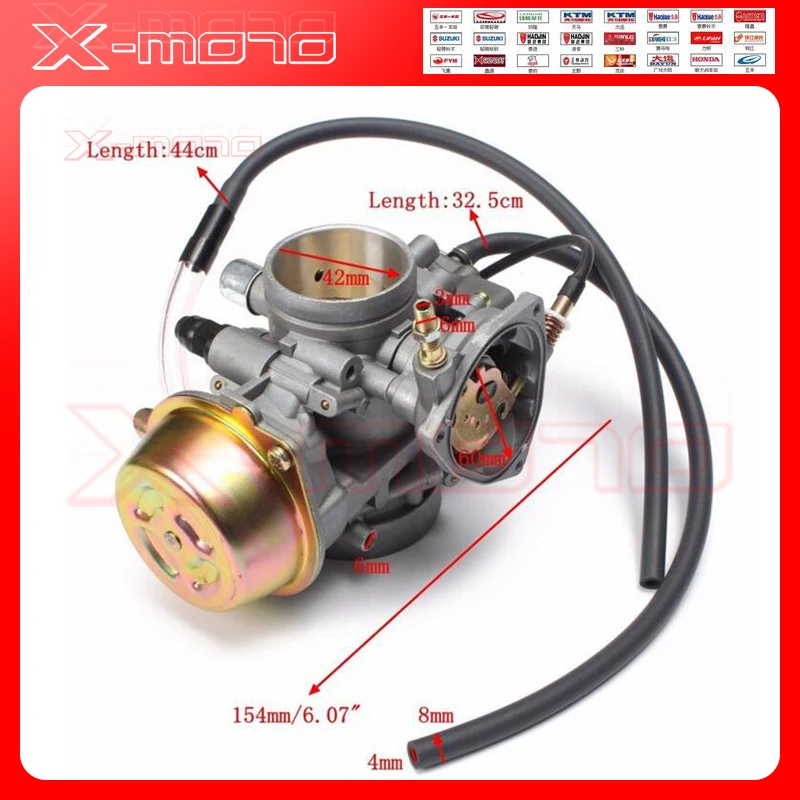
At the end of the cycle remove the components from the bath. If they are not clean replace them in the bath until the cleaning is complete. Then rinse them in fresh water to remove all traces of the cleaning solution and allow them to dry.
Safety note: DO NOT reach into an operating ultrasonic bath. Instead remove the basket if you want to inspect or rearrange the parts.
Step 3: Reinstalling the Carburetor
Return the Yamaha Raptor ATV carb to its original position by adjusting the air intake tubes and tightening the four screws so that they stay in place. Insert the throttle cable with the cable holder into the carburetor. To do this, rotate the when clockwise and fit the cable holder inside. Use needle nose pliers to make things easier. Be sure that it will not budge once you close everything up.
Tighten the clamps from the air filter housing to ensure that your Yamaha Raptor ATV carb stays put. Return the two cables attached to the carburetor. After this, return the throttle plate cover of your Yamaha Raptor carb by tightening the three screws holding it to the ATV.
After this, return the throttle plate cover of your Yamaha Raptor carb by tightening the three screws holding it to the ATV.
Return the fuel tank by attaching the three bolts back on the assembly. You will then have to connect the fuel line. Use needle nose pliers to help you with this process. After this is done, tighten the screws in front of the radiator as well as the screws to hold the tank together. Return the fuel tank cover.
Screw the front fender back on. Return the ATV lights. Fix the front panel by securing the two allen bolts once more. Lastly, return the air filter housing and the air filter to the ATV.
Admire the piece of work you just put back together.
Voila! Start the engine, and your Yamaha Raptor ATV should be good to go.
More Operating Tips
Oils that rise to the surface of the bath should be skimmed off and disposed of properly. When the solution becomes discolored or cleaning time takes longer it is time to replace it.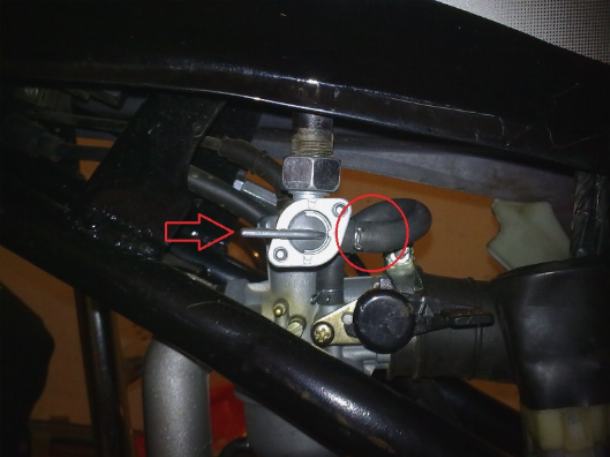 Drain the tank and dispose of the spent solution according to local regulations. Take the time to remove sludge that settled to the bottom of the tank. Clean the tank using a cleaning process recommended by the manufacturer.
Drain the tank and dispose of the spent solution according to local regulations. Take the time to remove sludge that settled to the bottom of the tank. Clean the tank using a cleaning process recommended by the manufacturer.
Questions: Contact the iUltrasonic ultrasonic cleaning experts at 973 821-4400
Disclaimer: This advice is not provided by a licensed mechanic. Follow at your own risk. We assume no liability for any damages caused by following the advice in this article.
It often seems like an insurmountable task for beginners to tune and adjust the carburetor of an ATV, but in fact, it is far from being the case. Using our instructions, you can easily set up a carburetor with your own hands.
Due to incorrect carburetor settings, problems such as: acceleration dips, jerks while driving, uncertain start of the engine, poor acceleration dynamics, overheating, loss of power, increased fuel consumption, formation of deposits in the combustion chamber.
So what exactly are we going to tune?
Attention! The adjustment is carried out under the condition of a warm engine and a clean carburetor.
First, make sure there is no condensation in the carburetor. First, you need to drain the gasoline from the float chamber, for this you need to close the fuel cock and partially unscrew the screw No. 1, after the gasoline has drained from the float chamber, tighten the screw No. 1.
Let's look at photos of candles with various deposits and defects.
A 100% indicator of a correctly adjusted combustible mixture is carbon deposits on a candle.

Consider the location of the screws for adjusting the quality of the mixture and idle speed of carburetors of different models.
#1 Float chamber plug; No. 2 Mixture quality screw;
#3 Idle adjustment screw.
1 - quality adjustment screw at idle; 2 - fuel inlet fitting; 3 - fitting through which you can sleep fuel from the float chamber; 4 - screw-plug of the float chamber.
1 - ventilation tube; 2 - idle speed adjustment screw; 3 - screw for adjusting the composition of the air-fuel mixture.
ATV carburetor speed and mixture adjustment.
1.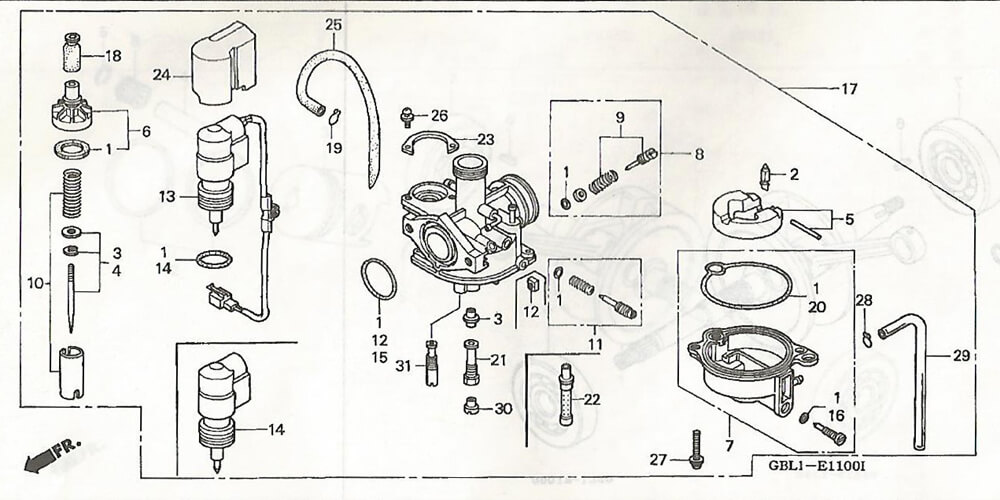 Start and warm up the engine until it reaches operating temperature.
Start and warm up the engine until it reaches operating temperature.
2. Adjust the idle screw to set the idle speed to normal. Completely, until it stops, tighten the fuel mixture screw, the engine should stall. If this does not happen, check the tightness of the air supply system from the air filter.
3. Loosen the fuel mixture screw 1 turn. (Turning the screw clockwise, we enrich the mixture, unscrewing it counterclockwise, we lean).
4. Start the engine and, by adjusting the idle speed screw, set the speed slightly higher than normal
5. Slowly unscrew the fuel mixture screw until the engine reaches maximum speed (we unscrew the screw no more than 2 turns, but depending on engine wear and other malfunctions, the range may vary).
6. Re-adjust the idle screw to set the idle speed to normal.
7. Press the throttle trigger several times, check if the idle speed is stable.
Adjustment of the mixture quality with a needle.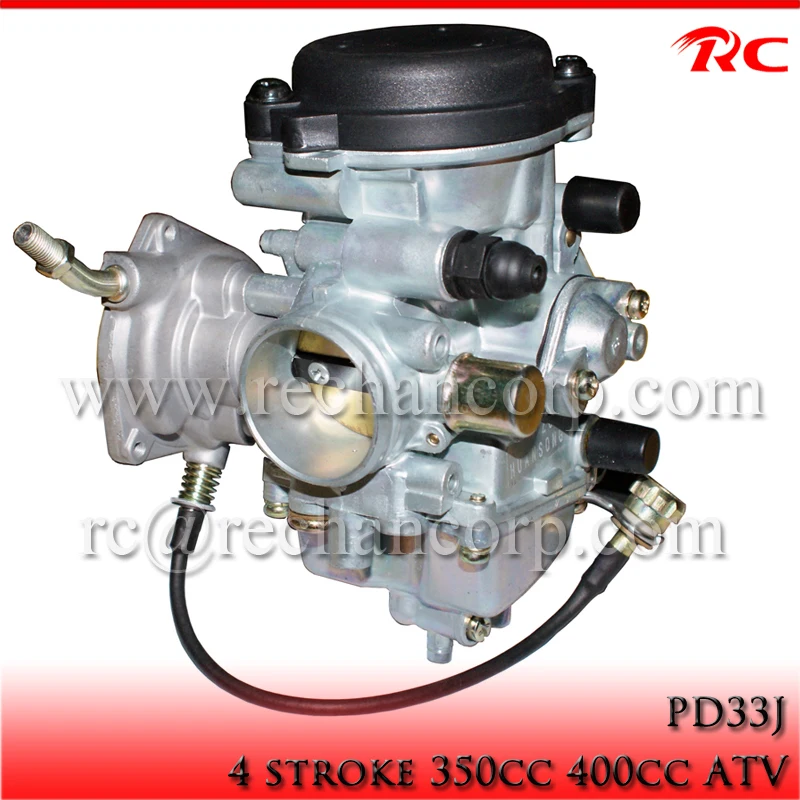
Probably you have heard more than once about adjusting the quality of the mixture on the carburetor by manipulating the needle. I note that these are extreme measures, for the initial adjustment, use the mixture quality screw, and only if you do not get the desired result, unscrew the mount and remove the needle. What does she represent? This is the main element that regulates the amount of gasoline supplied to the combustion chamber. Connected directly to the throttle handle through a cable. When you turn the knob, the needle rises higher, opening up a channel for fuel, thereby delivering more mixture, which increases power, which translates into speed.
You will see 5 grooves on the needle at the attachment point. Initially, the retaining ring fixes it in the central position, this is the best option. But sometimes it is not possible to achieve the required quality of the mixture. Then we will need the remaining grooves, 2 on top and 2 on the bottom, this suggests that we can adjust the dose gradually.
Lifting the retaining ring up and locking it in this position lowers the needle, which, in turn, blocks the channel more than usual. Gasoline enters less than air, and the mixture becomes leaner. Lowering the ring down, we raise the needle, and everything happens exactly the opposite.
Be aware that an excessively lean or rich mixture can lead to serious malfunctions from overheating to loss of power, carbon deposits in the combustion chamber and all the consequences that follow from this. Keep an eye on the condition of the spark plug electrodes, this is the main indicator that will help you determine the quality of the mixture.
If you have any questions about the adjustment and tuning of the carburetor, you can ask them below in the "Comments" column.
If pops are heard when starting or operating the ATV, the rider must definitely figure out why the ATV is firing.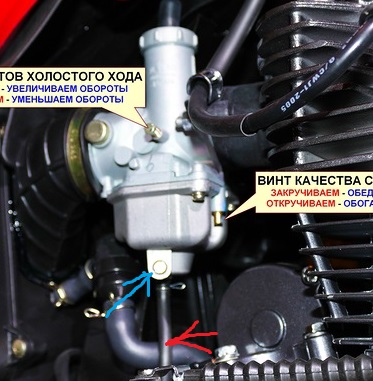 The fact is that such a problem occurs with various breakdowns, ranging from the carburetor to the ignition. This means that ignoring the “shots” will lead to a number of malfunctions, including: valve burnout, engine overheating, cylinder compression failure, damage to the intake system, etc. Remember that even if you decide to buy a top-brand quadric, it will need to be regularly service.
The fact is that such a problem occurs with various breakdowns, ranging from the carburetor to the ignition. This means that ignoring the “shots” will lead to a number of malfunctions, including: valve burnout, engine overheating, cylinder compression failure, damage to the intake system, etc. Remember that even if you decide to buy a top-brand quadric, it will need to be regularly service.
ATV muffler popping can be caused by a number of problems. Their list includes:
Poor quality fuel (with impurities or water) can also cause the problem. Therefore, before diagnosing an ATV, it is recommended to drain the old gasoline and fill in new fuel.
The most common reason an ATV fires and stalls is an improperly prepared fuel mixture. For example, if the composition is too lean, the rider will hear pops coming in bursts, and their frequency will increase as the rpm increases.
But if there is too much gasoline in the composition (rich mixture), part of the fuel remains on the walls of the muffler, and then explodes. A sharp ignition of the settled mass leads to strong cotton and burnout of the system components.
You can determine the quality of the fuel mixture not only by "shots", but also by the spark plug. If the mixture is poor, the candle will have a pale hue. And with an excessively rich composition, a velvet soot is formed on the component.
A simple reconfiguration of the ATV carburetor will fix the problem. By adjusting the needle valve, the rider can change the ratio of gasoline and oxygen.
Another reason why the ATV shoots in the muffler is a contaminated fuel mixture at the intake.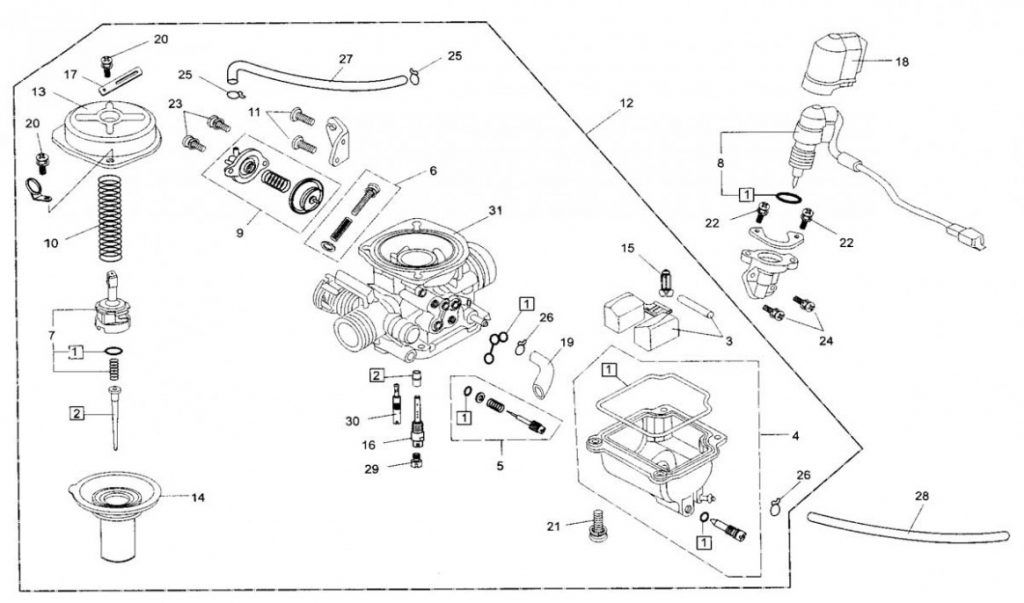 The cause of the problem may be a clogged filter, damage to the sealing gasket, or a depressurized pipe (a crack or gap has formed). Replacing components and checking the tightness of the system will help solve the problem.
The cause of the problem may be a clogged filter, damage to the sealing gasket, or a depressurized pipe (a crack or gap has formed). Replacing components and checking the tightness of the system will help solve the problem.
Sometimes pops appear even after replacing or upgrading the muffler. In this case, the owner of the equipment needs:
Popping can also occur due to high crankshaft speed. For example, with a reduction in the number of flashes at high speeds, the system delivers maximum fuel for some time. This leads to the fact that the mixture enters the muffler and begins to "explode" in bursts. This problem is especially noticeable when decelerating after a long acceleration.
The most common problem with the ignition system is considered to be a weak spark on the candle.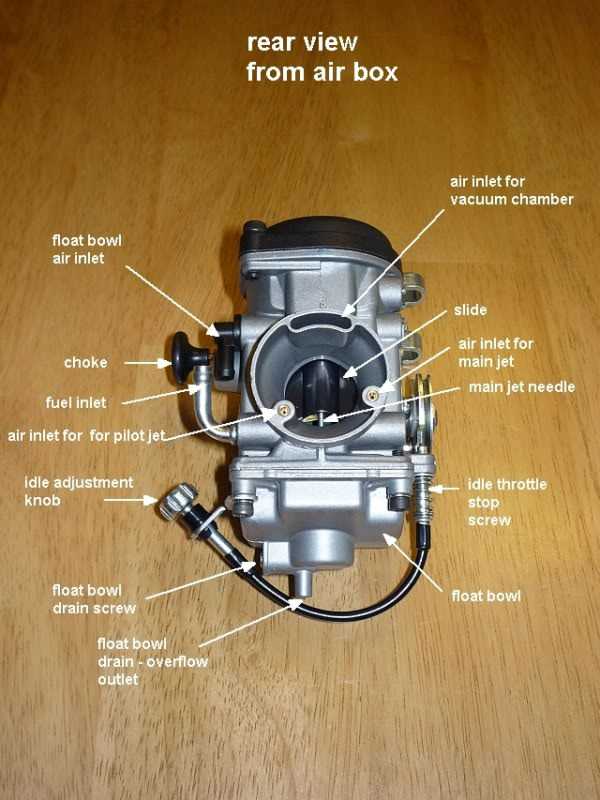 It is because of this that the quadric begins to stall or make “pops”. Therefore, the driver must first check:
It is because of this that the quadric begins to stall or make “pops”. Therefore, the driver must first check:
Sometimes the problem appears after installing a new spark plug. In this case, you need to make sure that the glow number of the component is suitable for a particular motor.
If everything is in order with the spark plugs, you need to check the ignition timing. It may be set incorrectly, due to which the ignition is triggered late. This leads to the fact that part of the fuel mixture burns out in the exhaust manifold, which causes cotton. However, this problem is not limited to one "shots". Late ignition leads to burnout of the exhaust valve, and this is a very serious "disease".
The problem of "shots" in the muffler is relevant both for ATVs with a carburetor and for models with an injector.